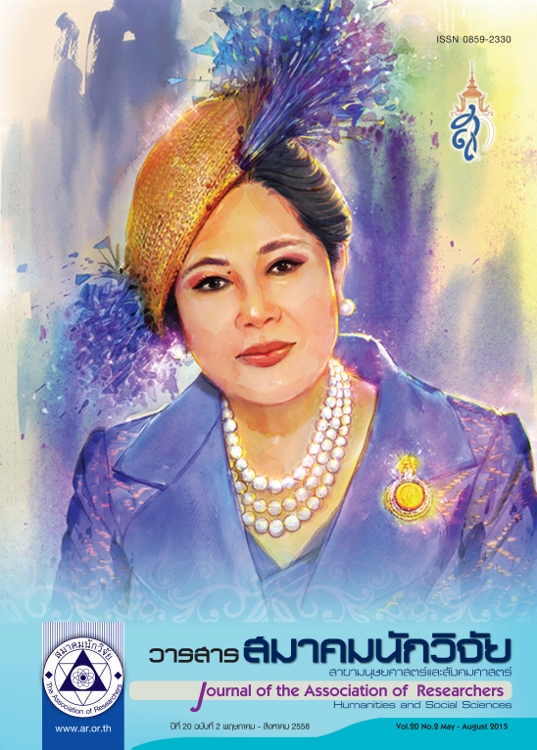Affecting Factors on Investment Pattern Decision for Financial Liquidity Problem Solving in Hotel and Lodging: Nakhon Pathom and Samut Songkram
Main Article Content
Abstract
The purpose of this study was threefold : First, to study affecting factors on decision making for selecting the investment patterns of entrepreneurs of hotel and lodging entrepreneurs in the area of Nakhon Pathom and Samut Songkram; Second to create a fit pattern for solving financial liquidity problem; and Third, to determine the way for solving financial liquidity. This study used both methods : qualitative and quantitative technique. Two sources of data came from in-depth interviewing one group of entrepreneurs and from questionnaires: 189 population entrepreneurs. Statistic were used in this study as descriptive and Binary logistic regression analysis. Research results were as follows: The affecting factors on decision making for selecting the investment patterns of entrepreneurs were as: Infrastructure and Market. Both factors could be explained the variance of decision making of entrepreneurs at 94.20 percent. The channel to solve business financial liquidity problems was using the way of His Majesty the King Philosophy suggestion: Sufficient Economy and depending on Bank as much as necessary.
Article Details
บทความที่ปรากฏในวารสารนี้ เป็นความรับผิดชอบของผู้เขียน ซึ่งสมาคมนักวิจัยไม่จำเป็นต้องเห็นด้วยเสมอไป การนำเสนอผลงานวิจัยและบทความในวารสารนี้ไปเผยแพร่สามารถกระทำได้ โดยระบุแหล่งอ้างอิงจาก "วารสารสมาคมนักวิจัย"
References
การเมืองพ่นพิษฉุดเศรษฐกิจดิ่ง. (2556, เมษายน). กรุงเทพธุรกิจ Biz Week, 5 (303), หน้า 12.
การท่องเที่ยวแห่งประเทศไทย. (2556). สรุปสถานการณ์การท่องเที่ยวภายในประเทศ ประจำปี 2555. กรุงเทพฯ: อมรินทร์พริ้นติ้ง แอนด์ พับลิชชิ่ง.
ชนงกรณ์ กุณฑลบุตร. (2549). การบริหารธุรกิจระหว่างประเทศ (พิมพ์ครั้งที่ 9). กรุงเทพฯ: จุฬาลงกรณ์มหาวิทยาลัย.
ธนาคารแห่งประเทศไทย. (2557). คณะกรรมการนโยบายการเงินมีการลดอัตราดอกเบี้ย. [ออนไลน์]. เข้าถึงได้จาก: http://www.bot.or.th/thai/economicconditions/pages/index.aspx (วันที่ค้นข้อมูล 13 เมษายน 2557).
บุญฑวรรณ วิงวอน. (2556). การเป็นผู้ประกอบการยุคโลกาภิวัตน์. กรุงเทพฯ: สำนักพิมพ์แห่งจุฬาลงกรณ์มหาวิทยาลัย.
สำนักงานสถิติแห่งชาติ. (2556). ประมวลข้อมูลสถิติที่สำคัญของประเทศไทย. กรุงเทพฯ: คณะรัฐมนตรีและราชกิจจา นุเบกษา.
Brouther, K. D. and Nakos, G. (2004). SME entry mode choice and performance: A transaction cost perspective.
Journal of International Business Studies, 9 (3), 229 – 247. Buckley, P.J., and Chapman, M. (2013). The dynamics of international competition. International Business Review, 20 (1): 129 - 130.
Chaundy, D. (2002). Foreign Direct Investment in Atlantic Canada. Retrieved January 25, 2013, from http: //www.apec- econ.ca/FDIExecsummary.pdf
Davidson, W.H. (2013). Beyond re-engineering: The three phases of business transformation. IBM systems Journal, 52 (1): 475 - 489. Dunning, J.H. (2013).
The paradox of knowing. Journal of International Business Studies, 26 (6): 414 - 417.
Ghatak, A. and Halicioglu, F. (2006). Foreign Direct Investment and Economic Growth: Some Evidence from across the World.
Global Business and Economics Review, 9 (4), 381 – 394.
Johnson, C. (2002). Locational Stategies of International Hotel Corporations in Eastern Central Europe, Thesis Publishers at University of Fribourg, Switzerland.
McIntosh, W.R., and Goeldner, R.C. (2003). Tourism : Principles, practice, philosophies. New York:
John Wiley & Sons. Root, F.R. (2006). How to ensure a successful entrance to Brazilian market. The American Journal of Sociology, 78(6): 1360 - 1380.
Treviño, L.J., and Mixon, F.G., (2010). Strategic factors affecting foreign direct investment decision by multi - national enterprises in Latin America. Journal of World Business, 41(4): 639 - 651.


